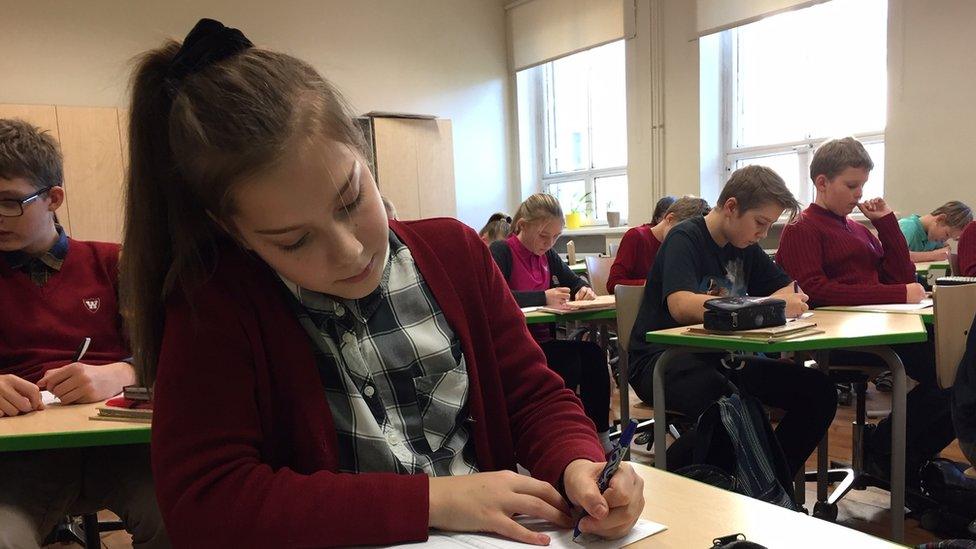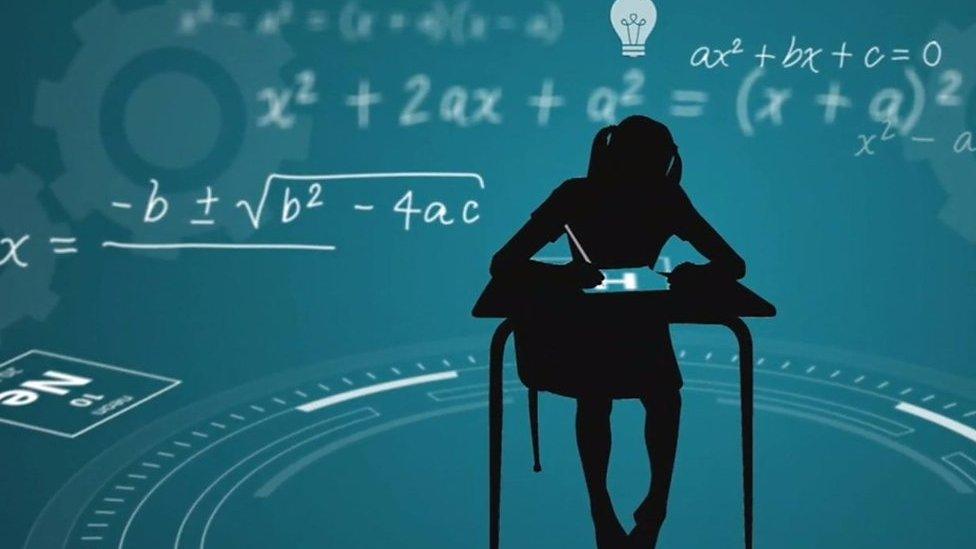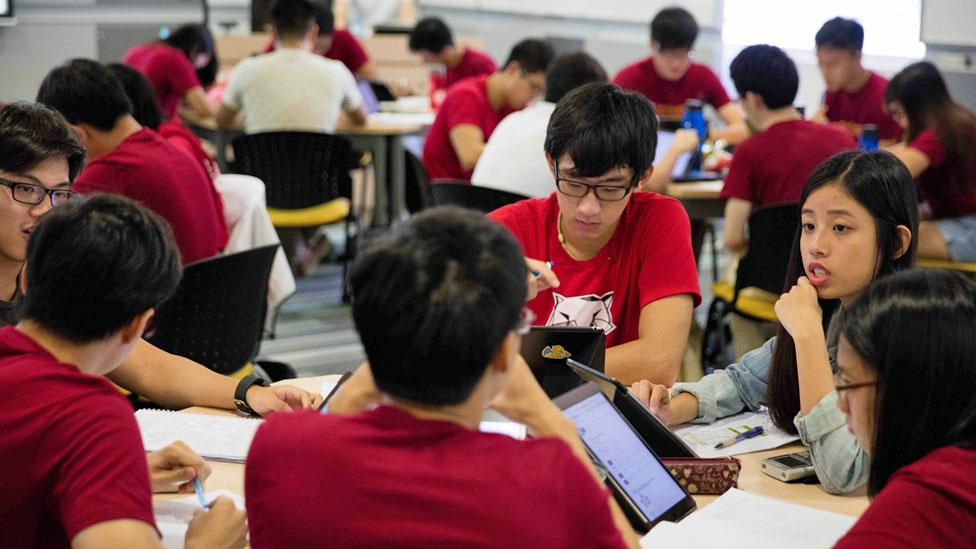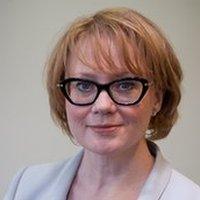Pisa rankings: Why Estonian pupils shine in global tests
- Published
Why do Estonian children start school at seven years old?
Estonia is Europe's newest education powerhouse.
It outperforms the major European economies, including the UK, in influential global education tests.
These Pisa tests measure the ability of 15-year-olds to apply their skills and knowledge to real-life problem-solving in reading, maths and science.
The OECD has run the tests since 2000, and most middle and higher income countries take part. The latest results are published on Tuesday.
In the Pisa results published in 2016, Estonia came third in science while the UK was ranked 15th, and in reading Estonia was ranked sixth - far above the UK's 22nd place.
UK spending on education is relatively high compared to the average across larger economies, but the same is not true of this small Baltic state.
Estonia has made high quality early years education a priority.
Kindergarten from age of three
It's drop-off time at Kelmikula kindergarten in the capital, Tallinn.
Mums Kristin Talvik and Elvira Uustalu both have six-year-old children in the oldest group.
That means they'll start compulsory schooling next year at the age of seven, so parents rely on kindergarten to get them ready.
"It's very important because learning will be so fast. He'll need to ask teachers questions, raise his hand, be brave" says Kristin.
"The most important thing is that he is socially ready. "
Almost every child in Estonia comes to Kindergarten from the age of three, or even earlier.
Parents have to make a contribution, but it is capped as a proportion of the minimum wage.
So, for these Tallinn mums Kristin and Elvira, that means up to €80 (£70, $90) a month per child.
'Ready to learn'
Kindergartens expect children to learn through play directed by teachers, with some more formal learning gradually introduced.
Elvira tells me education is important but "it's also important to do it in a way that they enjoy".
This is where Estonia begins to level up the attainment of all children, by making sure as many as possible are emotionally and physically ready to learn.
That result, according to the Pisa tests, in a smaller gap between rich and poor by the time they're teenagers.
The kindergarten manager, Riina Lall, says they don't grade children against tests when they leave.
Branwen Jeffreys explains what Pisa results are
"The children get a school readiness card describing their skills, their development and what more they need to do."
It is a world away from England, where at a similar age children are getting ready for their first national tests in Years 1 and 2.
Pupils sit phonics tests in Year 1 and standardised tests in reading, writing and maths in Year 2.
The results for the Year 2 tests are no longer used for league tables, and from 2023 they will be optional.
In the meantime it's not unusual for a six or seven-year-old to be sent home with past test papers to practise.
Estonia's system is quite different, but by the age of 15 its students are significantly outperforming the UK in every single subject domain of the Pisa tests.
Why Estonia puts all levels of ability together
In Estonia the universal basic education is in schools where pupils stay from age 7 to 16, with some students staying on to prepare for higher study.
Rando Kuustik, is the principal of Jakob Westholmi Gumnaasium in the Estonian capital, with almost 1,000 pupils and around 80 staff.
"If you teach them by different level of abilities you segregate them. Why would we do that in schools?"

Estonian pupils have performed well in previous Pisa tests
He's explaining to me why every subject in his school is taught in all-ability classes.
Putting students in different groups by subject or overall attainment, known as sets or streams in the UK, is very rare in Estonia.
Teachers are expected to find ways of levelling up pupils from all backgrounds within a couple of years.
There is a national curriculum, but relatively few measures to hold schools to account through results.
Aiming for Nordic standards
Teachers have a relatively high level of freedom to take risks in how they design lessons, says Rando Kuustik.
"I think the teachers are the main reason why we are doing so well, with the freedom to make their lessons, and the students are eager to learn. "
When Estonia regained independence from Russia, it looked to its neighbour Finland for education ideas.
Minister for Education and Research Mailis Reps says they have aimed for a Nordic level of equity, and that has a cost.
Apart from kindergarten, parents are not expected to contribute.
"Free in Estonia really means free. You don't pay for textbooks, you don't pay for the school lunches, you don't pay for school transportation."
Education, the minister argues, has always been valued in Estonia, but now it is in the context of an entrepreneurial and fast-growing economy.
"So what we have today is a tradition to study a lot, a little bit like Asian countries. We study for many many hours."
That means a lively and continuing debate among parents about whether there is too much homework.
E-schooling for all
Back at the school, that striving culture is clear when I sit down for lunch with some older students.
They are growing up in an economy where digital innovation is at the forefront.
Voting in general elections is now online.
Martin explains they have an e-school system, by which he means a lot of their homework is done and graded online.
Books are borrowed electronically too, which helps with the large amount of work they expect to do at home.
"As a small country, maybe we have a feeling that we need to prove ourselves. We have to be educated to get on," says Katja.
There are changes underway.
The government is trying to persuade more schools to test pupils at the ages of 10, 13 and 16 to track their progress.
It will have to balance this against the very high level of freedom that schools have now.
There are challenges too. Many of Estonia's teachers are nearing retirement age and, despite a big recruitment push, not enough are joining the profession.
In a system that values its teachers highly, it is the biggest risk to maintaining the remarkable progress its made.
- Published5 December 2016

- Published6 December 2016

- Published6 December 2016

- Published6 December 2016

